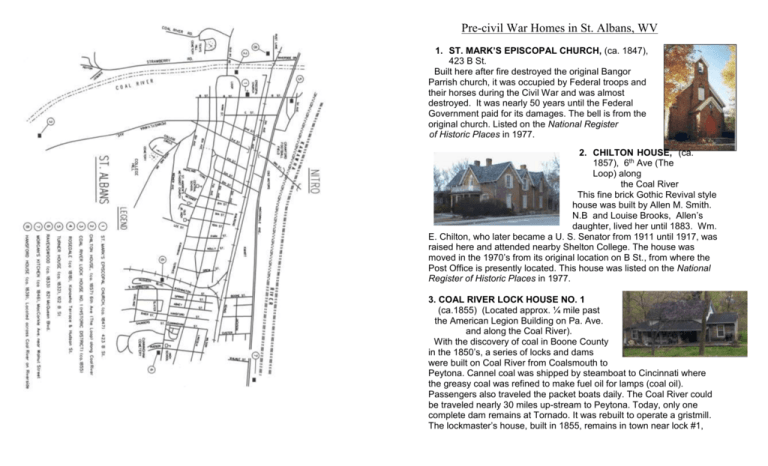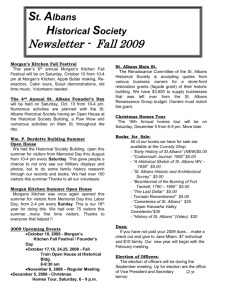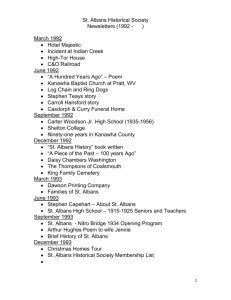to see the brochure - St. Albans Historical Society
advertisement

Pre-civil War Homes in St. Albans, WV 1. ST. MARK’S EPISCOPAL CHURCH, (ca. 1847), 423 B St. Built here after fire destroyed the original Bangor Parrish church, it was occupied by Federal troops and their horses during the Civil War and was almost destroyed. It was nearly 50 years until the Federal Government paid for its damages. The bell is from the original church. Listed on the National Register of Historic Places in 1977. 2. CHILTON HOUSE, (ca. 1857), 6th Ave (The Loop) along the Coal River This fine brick Gothic Revival style house was built by Allen M. Smith. N.B and Louise Brooks, Allen’s daughter, lived her until 1883. Wm. E. Chilton, who later became a U. S. Senator from 1911 until 1917, was raised here and attended nearby Shelton College. The house was moved in the 1970’s from its original location on B St., from where the Post Office is presently located. This house was listed on the National Register of Historic Places in 1977. 3. COAL RIVER LOCK HOUSE NO. 1 (ca.1855) (Located approx. ¼ mile past the American Legion Building on Pa. Ave. and along the Coal River). With the discovery of coal in Boone County in the 1850’s, a series of locks and dams were built on Coal River from Coalsmouth to Peytona. Cannel coal was shipped by steamboat to Cincinnati where the greasy coal was refined to make fuel oil for lamps (coal oil). Passengers also traveled the packet boats daily. The Coal River could be traveled nearly 30 miles up-stream to Peytona. Today, only one complete dam remains at Tornado. It was rebuilt to operate a gristmill. The lockmaster’s house, built in 1855, remains in town near lock #1, but the lock is now under water. This house and locks were listed on the National Register of Historic Places in 1997. 4. ROSEDALE (ca 1818), Kanawha Terrace & Hudson St. Located on the old James River & Kanawha Turnpike, this is the oldest house in St. Albans. Morris Hudson purchased this land from George Washington’s niece, Elizabeth Spotswood, who had acquired it from her great uncle George Washington. Hudson’s son Samuel Hudson built this house in 1818 originally where the High School now stands and it was moved in 1954. 5. TURNER HOUSE (ca. 1832), 102 B St This street (formerly brick) once lead to the wharf on the Kanawha River. This Gothic Revival house was built by St. Albans first mayor, John P. Turner and was later purchased by Stephen Teays in 1880. It’s St. Albans second oldest house. Noted for its decorative bargeboards and bracketed columns. This house has 9 rooms and 3 baths with 7 outside doors. 6. RAVENSWOOD (ca. 1833) 821 McQueen Blvd. Georgian (Classic Revival) style house built by Phillip Thompson for his son and is the third oldest house in town. Judge J. B. Drew, one of its owners, invented the story that Poe had written the “Raven” there. Also called Raven’s Court, a dairy was once run from the basement. Featured on Home and Garden TV in 2007. 7. MORGAN’S KITCHEN (ca 1846), MacCorkle Ave. near Walnut Street This is a typical one-room log structure used during its period and was originally located at Morgan’s Plantation near the present John Amos Power Plant. It was used to serve meals and also to treat wounded Union soldiers during the battle of Scary Creek nearby. It served solely as a kitchen for the adjacent Morgan farmhouse, but it has a loft supposedly used by the slave cooks and family members. The kitchen was moved to this site in 1972 and is maintained by the St. Albans Historical Society. Open for groups by appointment and Sundays in the summer. The St. Albans Historical Society was started in 1972 to care for this cabin, as they still do today. 8. HANSFORD HOUSE (ca. 1839), Located across Coal River on Riverside Dr. & Rust St. near the Railroad Bridge. This brick house is called the John Hansford House and, according to family tradition, this house was partially destroyed by fire sometime before the Civil War. The foundation and possibly some of the walls were salvaged and rebuilt almost as it was before. Mollie Hansford and her family moved here after floating down from the Upper Kanawha Valley on a flat-boat in 1839. In her memoirs, Mollie said,” It was (located) on a beautiful situation with a large lawn sloping down to the river”. It is said that a wounded soldier from the Battle of Scary Creek lay on the floor and his blood stained the floor for many years. Printed by the St. Albans Historical Society – 2011 See: http://stalbanshistory.com











